Plainclothes Agents Arrest Young Protesters In Iran Rally

Reports from Zahedan in Iran’s southeast say plainclothes security forces violently detained dozens of protesters, especially teenagers, on Friday during protests.

Reports from Zahedan in Iran’s southeast say plainclothes security forces violently detained dozens of protesters, especially teenagers, on Friday during protests.
Hal Vash website, which monitors the news of Sistan-Baluchestan province, reported Friday that "arrests of Baluch citizens in the city of Zahedan has greatly expanded."
Meanwhile, activists reported the mass arrest of protesters by plainclothes forces in the city on Friday when they were returning home from Friday prayers.
A video released on social media shows the arrest of young protestors in Zahedan. In the video, plainclothes security forces are violently arresting several young protestors and taking them by force to the vehicles.
During the mass protests on the 17th consecutive Friday in Zahedan, several cases of shooting and firing of tear gas by the military forces have also been reported.
The regime had beefed up security measures in Zahedan since Wednesday on the eve of the 17th Friday of protests. They deployed security forces and set up checkpoints in many areas of Zahedan.
Despite tight security measures, thousands of residnets once again took to the streets in Zahedan and chanted anti-government slogans after participating in Friday prayers and listening to prominent leader Mowlavi Abdolhamid’s sermon.
The Friday protests in Zahedan started on September 30thwhen the people of the city peacefully demonstrated against the killing of Mahsa Amini in police custody and the rape of a 15-year-old Baluch girl by the Chabahar police chief. Regime forces opened fire killing almost 100.
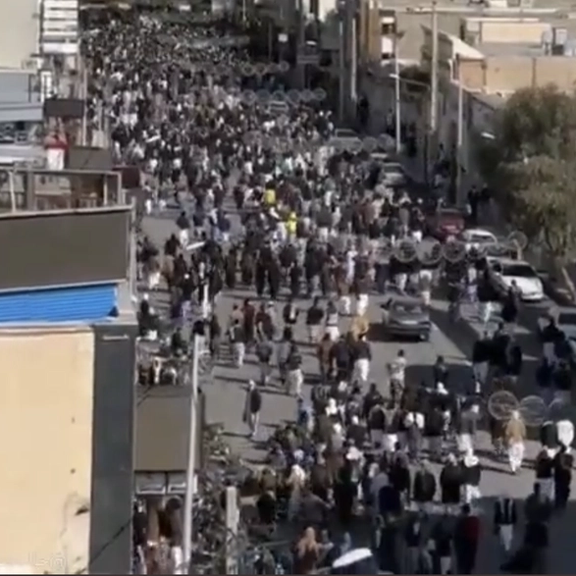
Security forces opened fire on protesters in the Iranian city of Zahedan who held rallies for the 17th consecutive Friday since protests broke out in September.
According to videos published on social media, the regime’s security forces also used teargas to disperse the residents of Zahedan who were chanting antigovernment slogans after they left the Makki Mosque, where they attended the Friday prayers led by the outspoken Sunni cleric Mowlavi Abdolhamid.
People in other cities of Baluch and Sunni majority Sistan-Baluchestan province, such as Rask and Khash also poured onto the streets to renew their opposition to the Islamic Republic. Similar rallies by Iranian Sunni Muslims in the city of Galikash, in the northern Golestan province, were also held outside the home of the city’s Sunni cleric Mowlvi Mohammad Hossein Gorgij, the deposed Friday Imam of Azadshahr. Meanwhile, in the southwestern city of Izeh, in Khuzestan province, a memorial ceremony was held for Hossein Saeedi, a protester who was killed in the city 40 days ago.
Gorgij, who was also summoned to the special court for clergy after his dismissal, appeared among the protesters and criticized the policies of the regime as incorrect, saying that “it has been 45 years that the Islamic Republic is chanting ‘death to America,’ that resulted in the fall of its currency to 450,000 (against the US dollar).
His dismissal has led to public outrage and protests. The Shiite clerical authorities made the move as a reaction to some of his remarks that were deemed insulting to Shia sanctities. Gorgij, however, issued a statement afterwards to apologize, clarifying that his speech was misinterpreted, and he meant no disrespect towards the Shias.

In the videos posted on social media Friday, people are heard chanting slogans against the regime, including its ruler Ali Khamenei who was referred to as “the dictator” as well as the Basij militia of the Revolutionary Guard, who are seen as responsible for than 500 civilian deaths in the past four months.
During his Friday prayer sermons, Mowlavi Abdolhamid, the most influential Sunni cleric in Iran, talked about widespread poverty across the country and emphasized that people supported the 1979 revolution in Iran for the same reasons they protest today. He also called for the abolition of the death penalty in the country. Most of the people executed in Iran are from the Baluch minority along with the Kurds. "Today, people are crying for the justice they wanted in the 1979 revolution; They want freedom, and they are stuck in poverty, hardship and problems."
He described the empathy and unity of Iranians inside and outside the country as exemplary, saying that the people of Iran regard freedom of speech and assembly as their rights and want to be able to choose capable managers to run the country.
"Our nation is not in favor of executions. This people are the owners of their country, and they want the authorities to exercise caution in issuing death sentences and executing people,” he added.
In the 133 days since the death in custody of 22-year-old Mahsa Amini, in addition to 500 people killed in antigovernment protests, about 20,000 people have been arrested and hundreds wounded seriously. Many young people have lost one or both eyes because security forces fired pellets at their faces.
The regime has so far executed four people and dozens are sentenced for ‘moharebeh’ -- meaning “fighting God'' in the lexicon of the Iranian regime -- and ‘corruption on earth’ that carry the death penalty.

An aide to Iran’s President Ebrahim Raisi says that recent protests “instigated by enemies” posed a “serious security challenge” to the Islamic Republic regime.
Mohammad Dehghan, the president’s legal aide was quoted by Fars news website Friday as saying that the “enemy succeeded” to instigate the “unprecedented” protests” carried out “by some elements who sold themselves out and some who were deceived.”
The Islamic Republic uses the term “enemy” to refer to the United States and its European and regional allies.”
As early as October, Supreme Leader Ali Khamenei blamed enemies for the protests that began in mid-September when Mahsa Amini, a 22-year-old woman who received fatal brain injuries in ‘hijab police’ custody and died in hospital.
Immediately, young people and especially women began protests across the country against the Islamic regime’s mandatory hijab and other restrictions and demanded an end to religious rule.
After Khamenei blamed the protest movement on foreigners, other senior officials began making the same claim and tried to accuse detained protesters of links with foreign countries.
Raisi’s aide also claimed that tens of security forces killed during protests “were unarmed,” while thousands of videos and photos show how they used all sorts of weapons, including shotguns, pistols and even assault rifles to shoot protesters. Over 500 civilians have been killed and hundreds injured, with scores losing one or both eyes.
The United States and its European allies have strongly condemned Tehran for the violent suppression of the protests and imposed multiple sanctions on Islamic Republic officials and entities.
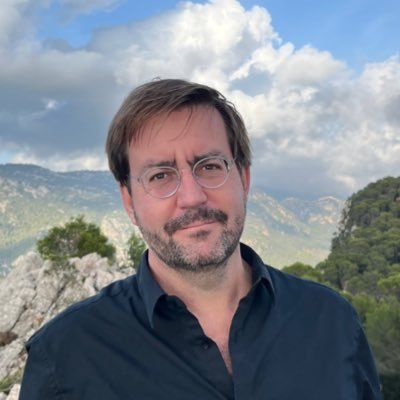
As scores of journalists have been arrested during the protests in Iran, Reporters Without Borders (RSF) announced that the Islamic Republic is determined to block all information channels.
Referring to detention of journalists in Iran, the RSF Executive Director Christian Mihr said Wednesday "It is important that the world learns about the brutality of the Iranian regime."
He said despite the arrests and threats to journalists in Iran, they "bravely continue to do their work."
According to the organization, since uprising against the regime in Iran, at least 55 journalists, including 16 female ones, have been arrested, and 27 of them are still behind bars.
The RSF further went on to say that 28 others were set free with large bails, but heavy prison sentences have been issued for a number of journalists.
Since the beginning of 2023, eight journalists have been arrested and four of them have been temporarily released on bail.
The Committee to Follow up on Situation of Arrested Journalists has prepared a list of these people saying at least 24 journalists are still under arrest.
Elaheh Mohammadi and Niloufar Hamedi, who published the news about the death of Mahsa Amini in police custody for the first time, are among the ones behind bars.
After their arrest, the Intelligence Organization of the Revolutionary Guard and the Ministry of Intelligence issued a joint statement accusing the two of espionage.
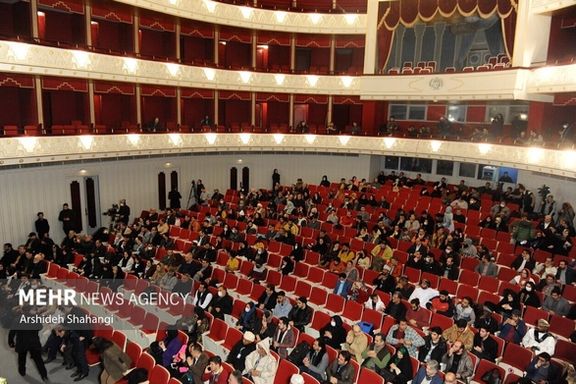
Iran’s Fajr Film Festival, the Islamic Republic’s biggest, has been snubbed by moviemakers and moviegoers amid ongoing protests all over the country.
The film festival is part of a series of events to mark the 44th anniversary of the Islamic Revolution marked by 10 days of state-sponsored ceremonies dubbed the decade of Fajr – which literally means dawn.
The trio of festivals – along with a theater and a music festival – have faced boycotts by numerous artists and art enthusiasts in recent years, but the current wave of protests and the regime’s heavy-handed crackdown seems like the coup de grâce to the most significant propaganda gala of the Islamic Republic.
Despite the government’s efforts to portray the events as popular as they used to be a decade ago, the theater festival was inaugurated in the sparsely attended Vahdat Hall this week.
It is ironic that even the most “prestigious” cultural events of the Islamic Republic are held in halls constructed prior to 1979 in the era of monarchy, as the clerical regime never truly invested in culture, and considers most of its representations un-Islamic except for a couple of weeks during the celebrations for the establishment of the Islamic Republic.
Even though photos of the empty hall during the theater festival’s opening ceremony were reported even by state media and outlets affiliated with the Revolutionary Guards, Mohammad Mehdi Esmaili, the Culture and Islamic Guidance minister, said that the event was welcomed by the people.

Since the beginning of the ongoing uprising in mid-September, many celebrities were banned, arrested or summoned by the judiciary for their solidarity with the current movement. Some of the most popular actors and artists even emigrated from the country to be able to express their support for the antigovernment protests freely and without fear of arrest.
Many actors and filmmakers had announced their boycott of the festival weeks before the start of the event, prompting the authorities not to announce the films selected to be screened during. Something unprecedented that took place this year was that the tickets for the movies were sold without the names of the works, because the government feared that if it announced the flicks, more artists would announce their opposition to the event. Of course, their trick turned out to be ineffective as some actors actually announced their boycott after their films were selected for screening, such as Haniyeh Tavassoli. Most of the actors, actresses and even directors do not have a say in the screening their movies because almost all of the productions in Iran are sponsored by state organizations.
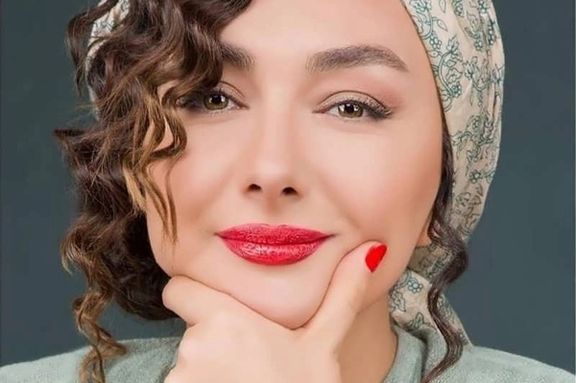
The festival had always been dominated by the works produced by government organizations and propaganda institutes but this year the level of audacity of the regime is even higher as authorities have announced that no movies that draw a grim portrait of the society were selected for screening. The committee tasked with selecting the movies is comprised of regime insiders, some of whom were not even film industry figures, such as Reza Pourhossein, a cultural manager and a professor of psychology at the University of Tehran.
The secretaries of the festivals and their juries are also selected from the figures close to the regime and known for works that promote regime propaganda, such as the secretary of the film festival Mojtaba Amini, a producer who was involved in the attacks on the Saudi embassy when it was ransacked by IRGC’s basij militias in January 2016. The secretary of the Theater festival called those who boycott the event “cultural dictators” at the opening ceremony.
The antigovernment protests, coupled with economic woes and political uncertainty, have clouded the cultural landscape of the country so much that the culture minister was reported asking theater directors and singers to start holding performances so that the regime can pretend the situation is back to normal.

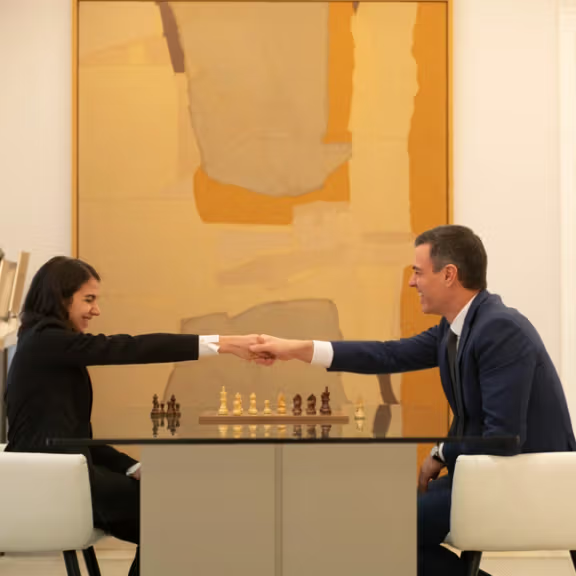
An Iranian chess player, who defected to Spain after she competed without hijab, has met with Spanish Prime Minister Pedro Sanchez in Madrid.
Sarasadat Khademalsharieh arrived in Spain in early January after having made a bold statement in Kazakhstan's capital Almaty, where she had participated in the FIDE World Rapid and Blitz Chess Championships without wearing the compulsory hijab.
"How much I have learned today from a woman who inspires me," Sanchez posted on his Twitter account after hosting Khadem at his official residence Wednesday.
"All my support to women athletes. Your example contributes to a better world," he added.
In footage provided by the prime minister's office, Khadem is seen chatting with Sanchez without wearing a hijab. They later appear to engage in a game of chess.
In the past four years, dozens of Iranian athletes have defected to other countries in objection to Islamic Republic’s restrictive policies, including compulsory hijab for women during matches and a ban on competing against Israeli athletes.
Anti-regime protests against clerical rulers have been going on for more than four months when a 22-year-old Kurdish woman, Mahsa Amini, was killed in police custody for wearing "inappropriate attire".
The US-based Human Rights Activists News Agency (HRANA), one of the groups that monitors and publishes daily statistics about the protests, said Tuesday that 525 protesters have been killed from September 17 to January 23, including 71 children.